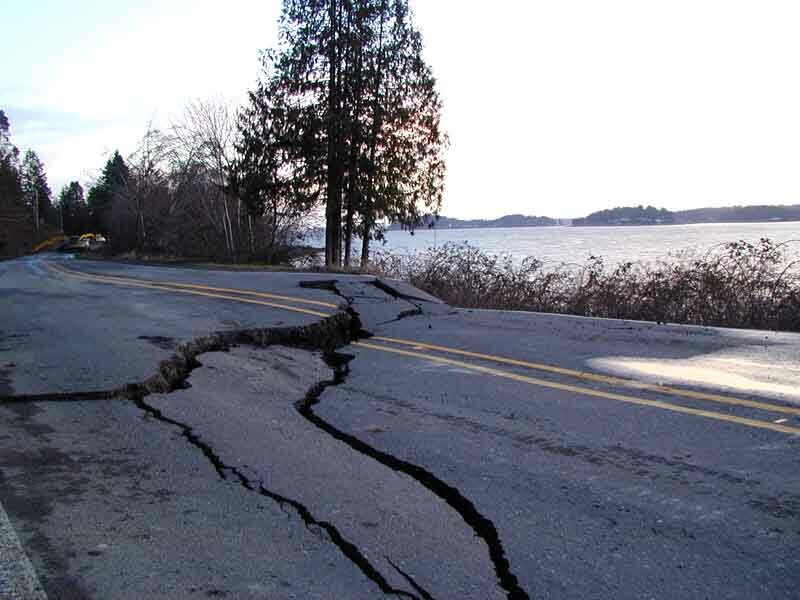 Slide crop from “Seattle Fault Scenario”
Slide crop from “Seattle Fault Scenario”
The news from Christchurch, New Zealand, that at least 65 people are dead following a 6.3 earthquake, arrives just days before Seattle’s own memorial of the February 28, 2001, Nisqually Quake, a 6.8 magnitude quake that lasted for 45 seconds. The tragedy in New Zealand is a reminder of how different things could have been, and a warning against complacency.
Arne Christensen, who has written about the history of earthquakes in the Northwest for us, notes that, “It looks like the Christchurch quake is similar to the scenario for a quake on the Seattle fault, and for what happened in Haiti last year: a shallow fault, centered very close to an urban center, producing sustained shaking that brings down masonry and concrete buildings in particular. Not a huge magnitude, but a lot of damage.”
Christensen collects stories from the Nisqually Quake on his blog, and they are still coming in, with details as fresh as if it had happened yesterday. One woman had taken her father to the Queen Anne Dick’s Drive-In, for a weekly meeting with a group of fellow elders:
We were sitting on hard chairs attached to small tables with the elders sharing stories when the room began to shake. A huge chandelier in the center of the two story room began to swing, and the cars reflected the ground movement by jumping toward the building and then away. Oh, no, an earthquake, I thought, but this is going longer than I want, and when will it stop? Should I try to get these elders under the tables to protect them if the building begins to cave in? But how would I get them back in their seats after it’s over?
 Lateral spreading (Photo: Nisqually Earthquake Clearinghouse)
Lateral spreading (Photo: Nisqually Earthquake Clearinghouse)
In 2005, a 12-member project team of scientists, civil, structural, and geotechnical engineers,planners, and emergency managers mapped out a “Seattle Fault Scenario.” They noted how much of Seattle’s ground, downtown and south of downtown, was likely to become liquefied in the event of a major quake, and that we’re likely to see lateral spreading and landslides as well.
They closed with action items like “increase awareness of threat” and “increase preparedness,” while worrying about the threat to Seattle’s transportation infrastructure. “At current state funding levels, WSDOT will complete their seismic retrofitprogram in 2070,” they noted, adding drily, “this is a long time.” If Seattle’s roads are compromised, you simply won’t be able to count on immediate assistance.
That puts the onus of earthquake preparation on all of us, instead. King County offers this checklist of things you should do beforehand, and what better time than now:
- Have and practice a family disaster plan.
- Establish meeting places and phone numbers in case family members are separated.
- Identify an out-of-state contact to call during a major disaster or emergency; it will be easier to call out of the area if local lines are tied up.
- Make sure everyone knows when and how to call 9-1-1.
- Keep your disaster supply kits up to date. Make sure you have kits for your home, vehicle, work and school.
- Get a tone-alert NOAA Weather Radio to receive emergency notifications and up-to-date information and instructions.
- Teach all family members when, where and how to turn off utilities. Make sure you have the appropriate equipment, such as a wrench, handy.
- Make sure you understand the emergency plans and expectations at your child’s school and your work.
- Preplan alternate transportation routes to and from work and other important destinations.
- Be sure to keep at least a half-tank of gas in your vehicle at all times; power outages often accompany disasters and gas stations rely on electricity to power their pumps.
- Know ahead of time what you should do to help family, friends or neighbors who are elderly or have special needs.
UPDATE: The above-mentioned Arne reminds me that many disaster plans assume home ownership, but that dense, urban Seattle has plenty of condo and apartment dwellers. So here is your checklist:
- Water in pouches, containers and a water filter
- Canned foods
- Pain killers, creams
- First aid kit
- Prescription medications
- Vitamins and supplements
- Entertainment items (books, board games and coloring books and activities)
- Lights (flashlights, lanterns, candles and oil lamps)
- AM/FM weather radio (hand-cranked, solar powered or battery operated)


